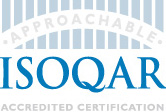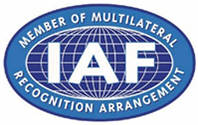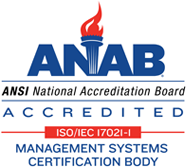
ISO 9001 – Quality Management Standard
ISO 9001 is the internationally recognized standard for the quality management of businesses. It prescribes systematic control of activities to ensure that the needs and expectations of customers are met. It is designed and intended to apply to virtually any product or service, made by any process anywhere in the world.
The benefits of adopting ISO 9001
Implementing a Quality Management System will motivate staff by defining their key roles and responsibilities. Cost savings can be made through improved efficiency and productivity, as product or service deficiencies will be highlighted. From this, improvements can be developed, resulting in less waste, inappropriate or rejected work and fewer complaints. Customers will notice that orders are met consistently, on time and to the correct specification. This can open up the market place to increased opportunities.
Implementing a Quality Management System will motivate staff by defining their key roles and responsibilities. Cost savings can be made through improved efficiency and productivity, as product or service deficiencies will be highlighted. From this, improvements can be developed, resulting in less waste, inappropriate or rejected work and fewer complaints. Customers will notice that orders are met consistently, on time and to the correct specification. This can open up the market place to increased opportunities.
Implementing a Quality Management System will motivate staff by defining their key roles and responsibilities. Cost savings can be made through improved efficiency and productivity, as product or service deficiencies will be highlighted. From this, improvements can be developed, resulting in less waste, inappropriate or rejected work and fewer complaints. Customers will notice that orders are met consistently, on time and to the correct specification. This can open up the market place to increased opportunities.
Why seek certification to ISO 9001?
- Registration to ISO 9001 by an accredited certification body shows committed to quality, customers, and a willingness to work towards improving efficiency.
- It demonstrates the existence of an effective quality management system that satisfies the rigors of an independent, external audit.
- An ISO 9001 certificate enhances company image in the eyes of customers, employees and shareholders alike.
- It also gives a competitive edge to an organization’s marketing
How do you start to implement ISO 9001? What is involved?
Once all the requirements of ISO 9001 have been met, it is time for an external audit.
- Identify the requirements of ISO 9001 and how they apply to the business.
- Establish quality objectives and how they fit in to the operation of the business.
- Produce a documented quality policy indicating how these requirements are satisfied.
- Communicate them throughout the organization.
- Evaluate the quality policy, its stated objectives and then prioritize requirements to ensure they are met.
- Identify the boundaries of the management system and produce documented procedures as required.
- Ensure these procedures are suitable and adhered to.
- Once developed, internal audits are needed to ensure the system carries on working.
Audit to ISO 9001
Once all the requirements of ISO 9001 have been met, it is time for an external audit.
This should be carried out by a third party, accredited certification body (CB) such as ISOQAR. In the USA, the CB should be accredited by ANAB. The chosen CB will review the quality manuals and procedures. This process involves looking at the company’s evaluation of quality and ascertains if targets set for the management program are measurable and achievable. This is followed at a later date by a full on-site audit to ensure that working practices observe the procedures and stated objectives and that appropriate records are kept.
This should be carried out by a third party, accredited certification body (CB) such as ISOQAR. In the USA, the CB should be accredited by ANAB. The chosen CB will review the quality manuals and procedures. This process involves looking at the company’s evaluation of quality and ascertains if targets set for the management program are measurable and achievable. This is followed at a later date by a full on-site audit to ensure that working practices observe the procedures and stated objectives and that appropriate records are kept.
After a successful audit, a certificate of registration to ISO 9001 will be issued. There will then be surveillance visits (usually once or twice a year) to ensure that the system continues to work. This is covered in more detail in ISOQAR’s ‘Audit Procedure ’ information sheet. Please get in touch if you would like a copy.
Why choose ISOQAR for your audit?
ISOQAR has an enviable record for customer satisfaction for its certification services. A friendly approach and a dislike of bureaucracy has led to unprecedented growth through referrals from contented clients. ISOQAR only employs auditors that have empathy with this approach. They are also carefully allocated by their experience in the industry they are auditing. This results in a practical, meaningful audit, carried out in an air of mutual understanding. ISOQAR firmly believes that its audits should benefit the organization that requests it, not be an intellectual exercise to ‘please’ the auditor.
What is the cost of an audit to ISO 9001?
For a fixed, written quotation, we require a few details regarding your organization. These can be submitted to ISOQAR via a short questionnaire or contact ISOQAR for more details. Quotations are provided without any obligation.
Where to obtain further information or help
The actual standard can be obtained from the American Society for Quality (ASQ) on 800 248 1946 or www.qualitypress.asq.org or the American National Standards Institute (ANSI) on 212-642-4900 or www.ansi.org.
The Institute of Quality Assurance operates a ‘ Quality Information Centre’. You may reach this by going to www.iqa.org. Click on ‘information centre’ then ‘resources’ for information and guidance.
Paton Press publishes a book called “ ISO 9001 In Plain English” written by Craig Cochran. Although it is Craig’s own interpretation of the standard, it certainly makes for simplified reading if you are new to the subject. Go to www.patonpress.com.
An organization in Canada has translated ISO 9001 into plain English. Although it is their own interpretation of the standard, it certainly makes for simplified reading if you are new to the subject. Go to www.praxiom.com.
Implementing ISO 9001
A document named ISO 9004 (obtainable as above) provides practical guidance and examples of how to interpret the requirements of ISO 9001.
Training courses about how to put together a Quality Management System are also readily available. Contact ISOQAR or Chambers of Commerce for more details.
For further details, please contact our office.


